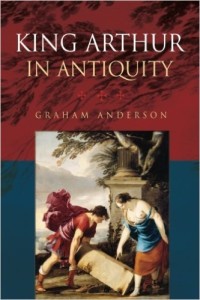 Why are the King Arthur stories so enduring in the popular imagination? And why did they captivate mediaeval Europe? Did the crusaders bring these stories to the middle east, or were the stories waiting for them when they got there? Anderson parses classical and mediaeval writing, as well as surviving folktales from the near east for evidence of Arthur figures, and not surprisingly, he finds not only similar tales of a “bear son” who is a military culture hero, but also evidence of some of Arthur’s companions as well. Perhaps these stories resonated with so many people because Indo-Europeans share the stories in common. As the author emphasizes, all this may be quite disappointing for those who cherish the idea that the stories emerged from the life of one embattled Briton in the fifth or sixth century, and it is the focus on this place and this era that may have caused Arthurian scholars to miss, or to fail to look for Arthur in all these “wrong” places — and times.
Why are the King Arthur stories so enduring in the popular imagination? And why did they captivate mediaeval Europe? Did the crusaders bring these stories to the middle east, or were the stories waiting for them when they got there? Anderson parses classical and mediaeval writing, as well as surviving folktales from the near east for evidence of Arthur figures, and not surprisingly, he finds not only similar tales of a “bear son” who is a military culture hero, but also evidence of some of Arthur’s companions as well. Perhaps these stories resonated with so many people because Indo-Europeans share the stories in common. As the author emphasizes, all this may be quite disappointing for those who cherish the idea that the stories emerged from the life of one embattled Briton in the fifth or sixth century, and it is the focus on this place and this era that may have caused Arthurian scholars to miss, or to fail to look for Arthur in all these “wrong” places — and times.
There have been others who have looked for a connection with an ancient people called the Sarmations, based on some graffiti on Hadrian’s Wall. But it seems no one has pulled together other likely candidates for Arthur figures that predate the embattled Roman-Celtic figure that has inspired to many historical and fantasy novels. Yet, given that the name Arthur has something do to with bears — “bear’s son” is the most common interpretation — and the decided lack of same in the British Isles, it seems to be a bit of an oversight. Anderson comes up with two candidates from the near east associated with similar stories to King Arthur — a Lydian named Artus (the same form as used in the French romances) and a Scythian named Arktouros. Both these figures have complicated relationships with brothers bearing a striking name-resemblance to Sir Kay, and cousins or nephews that share beheading stories and Green Knight figures with Gawain. There are also Guinevere figures, Waste land motifs, and a common theme of round tables (one of the above actually lives in a place whose name means “Table Town”).
Does all this mean there was no embattled Roman-Celtic figure holding back the Saxon hordes? Not necessarily. It just means that who ever he or they were — and there is a fourth century candidate with a rather illustrious military career named Artorius who served both on the islands and the continent — it means that the stories were attracted to this figure because they are great stories that resonated with people. Asnd given the time, they likely had a great need for great stories.
Now, all this is a bit heavy going for the average consumer of knightly tales, but it does provide a nice introduction to the kind of scholarly work that enables historical fiction writers to interpret the rather sparse tales. And, like other works that explore folklore archetypes, it shows just how widespread some of these enduring tales actually are. So, if you’ve a passion for the stories, and wonder how the Celtic tales came to resemble those of pre-Greece, this is the book for you. But I won’t be expecting any Discovery channel specials on this one any time soon, as there are very few visuals, no proof to be found in hill forts. Just a good bit of scholarship that eviscerates some fondly cherished notions that “our’ Arthur is unique.
(Routledge, 2004)
